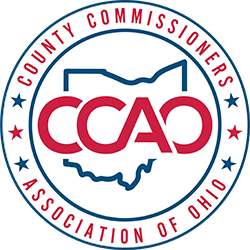Complete Story
03/05/2023
Happy March 1 birthdays!
Twenty-four counties were born on March 1, the most of any day.
March 1 is not only the birthday of the state of Ohio, but it's also the birthday of 24 counties! That's the most of any day. Read about the counties that celebrated their birthdays this week below, in order of oldest to youngest.
Muskingum County (219 years old)
Created out of land from Fairfield, Washington, and Columbiana counties, the origin of Muskingum County's name is disputed. The county itself credits the name as coming from the Delaware Native American tribe's word for "town by the river," but other sources claim the name means "swampy ground" or "elk's eye."
The Ohio Anti-Slavery Society, originally a branch of the American Anti-Slavery Society, was founded in Putnam in 1835 (Putnam was a separate town at the time, but it was annexed into Zanesville in 1872). Some of Ohio's most famous abolitionists were members of the society, such as Asa Mahan and John Rankin.
Athens County (218 years old)
Athens County was created out of a portion of Washington County in 1805. The county and its county seat are named after Athens, Greece, the city-state which was home to one of the earliest western democratic systems of government and was the flower of ancient Greek learning.
Ohio University, located in Athens County, was the first institute of higher learning chartered through an act of Congress, being chartered in the Ordinance of 1787. That also makes it the first land-grand university in the country as well. Among its founders was Rufus Putnam, a Revolutionary War general and cousin of the namesake of Putnam County (Israel Putnam).
Champaign County (218 years old)
Champaign County shares its name with a region of France, the name translating roughly to "open, level country." It was created out of portions of Greene and Franklin counties.
The county is home to the Cedar Bog Nature Preserve, one of the first preserves in Ohio to be purchased by the state using state funds. The preserve is home to a diverse array of flora and fauna, including three endangered species (the spotted turtle, the massasauga rattlesnake, and Milbert's tortoise-shell butterfly).
Geauga County (217 years old)
Geauga County gets its name from the language of the Onondaga First Name, from a word meaning "raccoon." The second county created out of the Connecticut Western Reserve; it is comprised of land originally belonging to Trumbull County.
A contentious disagreement over the location of the Geauga County seat eventually led to the creation of Lake County (see the Lake County birthday note in the March 6, 2023, issue of Counties Current for the rest of the story).
The Geauga County Fair is the longest running continuously operating county fair in the state, first taking place in 1823.
Miami County (216 years old)
Miami County is named after the Miami Nation, the Native American people who were indigenous to the area. It was created out of land formerly belonging to Montgomery County.
Miami County is home to an interesting piece of America's telecommunications history. The unincorporated community of Phoneton (or Phonetown, spellings vary) was established as a company town of ATT in the 1890s and served as a switchboard hub for several major telephone and telegraph lines for 40 years, until the company relocated operations to Dayton.
Knox County (215 years old)Knox County was created out of land formerly belonging to Fairfield County. It is named after Henry Knox, an office during the Revolutionary War and the first Secretary of War (he is also the namesake of the famous Fort Knox).
Knox County was the home of Lorin Andrews, a teacher and president of Kenyon College. He is famed as the "First to Fight," credited as the first Ohioan to volunteer for the Union in the Civil War. He was the first commander of the Ohio 4th Infantry. Unfortunately, Andrews contracted typhus (often called Camp Fever due to its prevalence in military camps before the rise of modern medicine) and died in September 1861. The 4th Infantry would later win fame for taking Cemetary Hill during the Battle of Gettysburg.
Licking County (215 years old)
Crafted out of a portion of Fairfield County, Licking County's name origin is disputed. The most commonly attested origin is that it's named for the salt licks that were in the area, although others claim it is an English corruption of a Delaware word meaning "where the flood waters recede."
The county is home to the Newark Earthworks. The largest earthen enclosure in the world, the Earthworks are a complex constructed by the Hopewell Culture between 100 BCE and 400 CE. The exact purpose of the Earthworks is still foggy, although one portion dubbed the Octagon Earthworks served as a lunar observatory.
Preble County (215 years old)
Named after Edward Preble, Preble County is comprised of land formerly belonging to Butler and Montgomery counties.
Preble was the main naval commander during the war and William Eaton, a former consul to Tunis, led eight Marines and hundreds of mercenaries to victory in the Battle of Derna, a decisive victory that functionally ended the war (and is immortalized in the line "From the Halls of Montezuma/To the shores of Tripoli" in the Marine Corps Hymn). The county seat is named after Eaton and a number of streets in Eaton are also named after significant figures in the war, including Barron Street, the location of the Preble County Courthouse. Israel Township and Somers Township, both in Preble County, are named in honor of naval commanders who served during the Barbary Wars.
Richland County (215 years old)
Richland County, so named due to its rich, fertile soil, was created out of land once belonging to Franklin County.
Richland County is the site of the former Ohio State Reformatory. Built in the late 1890s as a facility to (as the name suggests) reform male criminal offenders, the facility originally worked to teach inmates trades and educate them in order to produce better citizens upon their release. Like other reformatories of the era, it eventually shifted to a maximum-security prison facility. It closed in 1990 due in part to its deteriorating condition.
Wayne County (215 years old)
Named after General Anthony Wayne, also known as "Mad" Anthony Wayne, Wayne County was created out of land that was part of Ohio but not assigned to any county.
Wayne County was home to Charles W. Follis. Nicknamed the "Black Cyclone," Follis was the first African-American to play professional football. In 1904, he signed a contract with the Shelby Athletic Club (later the Shelby Blues). One of his teammates with the Blues was Branch Rickey, who would later help break baseball's color barrier by signing Jackie Robinson to the Brooklyn Dodgers.
Clinton County (213 years old)
Clinton County was created out of Highland and Warren counties and is named after George Clinton. Clinton was a soldier in the Revolutionary War, the first Governor of New York, and served as Vice-President under Thomas Jefferson and James Madison (he was in this role when Clinton County was created).
Clinton County was the site of important breakthroughs in aeronautics and meteorology. The home to the second phase of the Thunderstorm Project, a joint undertaking of the several federal agencies including the Army Air Force and the Navy, the project studied thunderstorms and how to use radar to help allow airplanes to safely navigate thunderstorms.
Fayette County (213 years old)Created out of Highland and Ross Counties, Fayette County is named after Marquis de Lafayette. Lafayette was a Frenchman who was an important officer and liaison to the French crown during the Revolutionary War.
The Fayette County Courthouse was the site of a riot in 1894, during which the Ohio National Guard fired upon members of a lynch mob. Five members of the mob were killed. The National Guard commander, Colonel Alonzo Coit was indicted for manslaughter but was acquitted. The bullet holes can still be seen in the courthouse's south doors.
Guernsey County (213 years old)
Guernsey County is named after the Isle of Guernsey. A small island in the English Channel, Guernsey was the original home of many early settlers in the county. Guernsey County was created out of Belmont and Muskingum counties.
Guernsey County was the site of one of the skirmishes with Morgan's Raid, the only Confederate incursion into Ohio during the Civil War. Three Union cavalry units engaged with the raiding force in Old Washington. Three Confederates were killed and eight captured.
Madison County (213 years old)
Madison County was named after James Madison, the then-President of the United States who made a number of contributions to the early establishment of the United States. It was created out of Franklin County.
Madison County's first Euro-American settler was more unique than most other counties'. Jonathan Adler was a native of Virginia who was captured in a Native American raid in 1782 when he was seven years old. He lived in a village of the Mingo Tribe and served as an interpreter with other white settlers as they entered the area. He later reunited with his family in Virginia before returning to Madison County with his wife.
Pickaway County (213 years old)
Pickaway County's name comes from an English corruption of a Shawnee tribe named Pekowi who lived in the area. It was created out of Fairfield, Franklin, and Ross counties.
The Pickaway County seat, Circleville, was established atop a Hopewell culture concentric earthwork. The city was originally laid out to integrate the earthworks as part of the city. Unfortunately, in the 1830s residents grew frustrated with the radial layout of the city and by 1856 had destroyed much of the earthworks to convert the city to a more conventional grid layout.
Jackson County (207 years old)
Jackson County is named after Andrew Jackson who, at the time of the county's creation, was a famed war hero during the War of 1812. He would later serve as the 7th President of the United States from 1829-1837. The county was created out of Athens, Gallia, Ross, and Scioto counties.
The county was the site of an early prosperous iron ore deposit. The iron from Jackson County was used for many purposes during the Civil War, including being used to build the USS Monitor, one of the country's first "ironclad" warships.
Brown County (205 years old)
Brown County was created out of Adams and Clermont counties. It is named after Major General Jacob Brown, a leader during the War of 1812.
Brown County contributed a plurality of militiamen to the colorfully-named "Squirrel Hunters" during a little-known episode of the Civil War. After the Confederacy defeated a Union contingent at Richmond, Kentucky, about 100 miles from the Ohio River, there were fears that the Confederates would follow up the victory with an invasion of Cincinnati. More than 15,000 militiamen from across Ohio come to Cincinnati to defend the city. A Confederate scout is said to have reported that, "They call them Squirrel Hunters; farm boys that never had to shoot at the same squirrel twice," a testimony to the Ohioans' accuracy. The attack on Cincinnati never materialized.
Clark County (205 years old)Clark County is named after General George Rogers Clark, a general during the Revolutionary War. The county was created out of Champaign, Greene, and Madison counties.
In 1902, the superintendent of Springfield Township Rural Schools, A.B. Graham, convened a meeting to create the Boys and Girls Agricultural Experiment Club to revolutionize agricultural education and non-formal youth development. The club would evolve into 4-H, which today educates more than six million kids a year nationwide.
Hocking County (205 years old)
Hocking County was created out of portions of Athens, Fairfield, and Ross counties. It is named after the Hocking River, which itself is named after the Delaware word for "bottle-shaped" or "gourd-shaped."
Hocking County is home to Haydenville, the longest-lasting company town in Ohio. The town, now an unincorporated community, was entirely owned by the National Fireproofing until 1964. The company built most of the existing structures in the community out of its own specialty fire-proof brick.
Logan County (205 years old)
Logan County is named after Benjamin Logan, a colonel of the Virginia militia during the Revolutionary War. In 1789, he led a raid into Shawnee territory, the events of which sparked the Northwest Indian War. Logan County was created out of Champaign County and is one of the few counties that is larger now than it was at its creation.
Logan County is home to the oldest concrete street in the country. George Bartholomew, who lived in Bellefontaine, invented concrete pavement in the late 19th century and his invention was used to pave Court Avenue outside the Logan County Courthouse. A portion of the street is maintained with his formula for concrete.
Perry County (205 years old)
Perry County was created out of portions of Fairfield, Muskingum, and Washington counties. Despite its location in southeast Ohio, it is named after Commodore Oliver Hazard Perry, the Hero of Lake Erie during the War of 1812.
Perry County was (and possibly, is) the epicenter of the "World's Greatest Mine Fire." During a strike by the miners of the Columbus & Hocking Coal and Iron Company in 1884, it is believed that striking miners pushed burning mine carts into the mines around New Straitsville. This caused the coal mine to ignite, creating an underground fire. In the initial years it was said that potatoes baked in the soil. The fire is believed by some to continue to burn today.
Allen County (203 years old)
Allen County was created out of land that previously had not been assigned to any county. The county is named after John Allen, an officer in the War of 1812 who died at the Battle of Frenchtown.
Allen County, particularly the county seat of Lima, was the site of oil boom in the late 1800s. It was one of the nation's leading oil producers until the Texas oil rush began in 1901. During its heyday, the Lima Oil Field produced more than 300 million barrels and saw the establishment of the Ohio Oil Company, which would eventually be bought by Standard Oil and later renamed Marathon Oil.
Mahoning County (177 years old)
Mahoning County is named after the Mahoning River, itself believed to draw its name from either the Lenape or Shawnee word for "deer lick" or the word for "place to get water." It was created out of Columbiana and Trumbull counties.
Mahoning County was the home of a Jewish-Polish immigrant family named Warner. Siblings Harry, Albert, Sam, and Jack Warner would go on to open motion picture theaters around the Mahoning Valley in 1905 and later move to Hollywood and found Warner Brothers Pictures.
Morrow County (175 years old)
Morrow County was created out of Crawford, Delaware, Knox, Marion, and Richland counties. It is named after Jeremiah Morrow, the ninth Governor of Ohio.
The Morrow County Courthouse is one of the oldest in the state. It was built in 1854, shortly after the county's establishment, and has served as the county courthouse continuously since.




